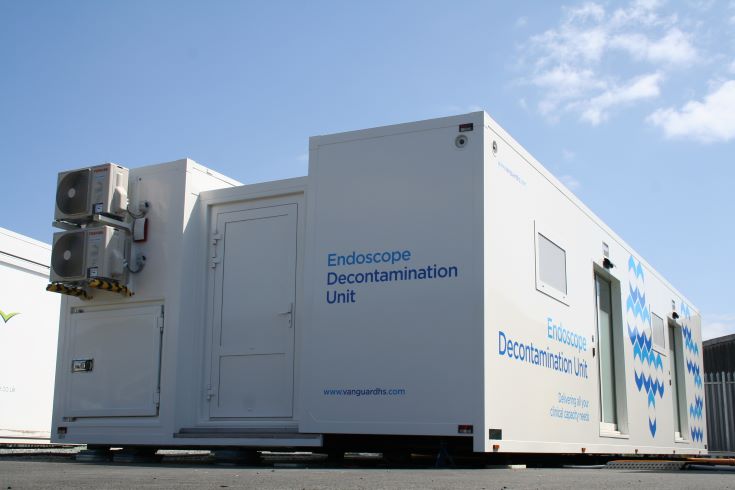The lesser-known hospital heroes
Close your eyes and think of a hospital. What do you see?
Fuelled by TV and film depictions, perhaps you see the busy environment of the Emergency Department? Or brightly lit operating theatres where surgeons and their teams carry out life-saving and pioneering work? These are the well-known and almost ‘public’ face of hospitals. And, of course, those departments are vitally important.
However, away from these more ‘high-profile’ and well-known aspects of medical life, lies the beating heart of hospitals. We’re talking about the departments, without which the work in the other areas could not continue. They may not be so instantly recognisable or camera-friendly, but they’re no less important.

It is often the sterilisation and decontamination departments that are worst affected by crises and disasters. Photo:Q-bital
Think, if you will, about where the many thousands of instruments used by surgical and endoscopy teams each and every day are cleaned and sterilised - everything from an instrument used in surgery to an endoscope used to detect abnormalities or indeed, give a patient peace of mind that there’s nothing to worry about.
Where do those instruments go after they have been used? How are they cleaned? How is this essential and highly specialist cleaning done? And what would happen if those services weren’t available for any reason and those tools couldn’t be cleaned?
Decontamination and sterilisation of any instrument used in a hospital environment has to be of the highest standard. A dunk in some hot, soapy water is not going to cut it (no pun intended). That instrument needs some serious cleaning. Think about how you’d feel if you knew a surgical or medical instrument about to be used in your procedure hadn’t been cleaned or sterilised properly…
For surgical instruments, there’s a strict process. First, a manual clean, followed by a stint in the washer disinfector. Then they’re packaged and wrapped, steam sterilised and placed on a cooling rack. The water used in these processes needs to be purified and disinfected and even the air in the department needs to be filtered to ensure optimal cleanliness.
Endoscopes need even more specialist cleaning in dedicated endoscope decontamination units which are specially equipped and use a high disinfectant washing process and purified water.
This is achieved successfully on a daily basis in hospitals around the world. But what about when things go wrong?
Sterilisation and decontamination departments often sit in the basements of hospitals, where their teams work seven days a week to make sure those instruments are cleaned to the most exacting standards and are ready for use – allowing the flow of patients and procedures to carry on unhindered. They may not get the ‘glory’, but their absence would certainly cause serious consequences for any hospital.
However, they are potentially vulnerable departments. Their physical location in the basements of hospitals can mean they are more likely to be affected by naturally occurring issues such as flooding, which can damage the equipment and leave the environment unsanitary due to contaminated flood water. These are not ideal conditions for ensuring sterility.
The high, and increasing, number of instruments making their way through the sterilisation and decontamination department can also lead to an increased level of ‘wear and tear’ on the specialist - and expensive - equipment needed to carry out the tasks.
Replacing the equipment or refurbishing the sterilisation or decontamination departments of a hospital - whether it is a planned process, or as the result of an emergency - leaves the hospital with the potentially significant issue; where to send the equipment to be cleaned?
There are usually two options for a hospital faced with having no decontamination or sterilisation facilities. One option is to use a neighbouring hospital’s sterilisation or decontamination facilities temporarily; but this can cause potential delays in getting vital instruments back to the right department, it may increase the risk of contamination and put additional pressure on neighbouring services. It may also require the hospital to buy more instruments to cover the increased ‘downtime’; in the case of endoscopes this is seriously expensive. The other option is to deploy a temporary solution which still allows cleaning to take place on-site.
When one of the Netherlands’ largest hospitals, the Medical Centre Leeuwarden, was undertaking a refurbishment project, it used a Q-bital designed and built mobile Central Sterile Services Department (CSSD) unit to ensure that equipment used in surgery at the hospital could continue to be sterilised on-site. By changing the staff scheduling, this was able to support 18 operating rooms to keep functioning as normal.
In addition, Q-bital Healthcare Solutions installed one of its specialist endoscope decontamination units at Queen’s Hospital in Romford, UK within days of a fire. This ensured that patient care could be maintained, allowing the hospital’s endoscopic procedures to go ahead without a backlog.
In both cases, patient treatment and care were able to continue as normal and the unsung hospital heroes carried on with their work – as quietly and effectively as ever.
So, while it’s unlikely that decontamination or sterilisation units will ever be the stars of a TV drama or Hollywood movie, they clearly are a vital part of the cast that don’t make the credits as often as they deserve.
Ruth Wozencroft works at Q-bital, specialists in healthcare solutions and a CRJ Key Network Partner.
Image credit: Dario Lo Presti|123rf
Ruth Wozencroft, 05/07/2019